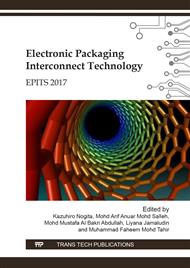p.83
p.91
p.95
p.101
p.107
p.115
p.122
p.128
p.134
Preliminary Study on Deformation and Recrystallization Behavior of Pure Tin for Mitigation of Whisker Growth
Abstract:
Since the mechanism of Sn-whisker growth is closely related with the behavior of deformation and recrystallization, understanding of the behavior is very important to establish the measure for mitigation of whisker growth. In this work, microstructural changes after heavy deformation by scratching were characterized by EBSD for a single crystal of β-Sn, and the following results were obtained. Three types of crystal grains appear immediately after the deformation; small grains in aggregation, large serrated grains and rim-grains. The small grains are considered to be formed by dynamic recrystallization. They continue to grow at a room temperature over a lengthy period of time. The large grain has a certain crystallographic relationship with the matrix where <100> axes of the large grain and the matrix are almost parallel to each other. The serrated boundaries of large grain are so stable that the large grain does not show a grain growth process. The stable boundary is considered to promote a continuous growth of whiskers.
Info:
Periodical:
Pages:
107-111
Citation:
Online since:
April 2018
Keywords:
Price:
Сopyright:
© 2018 Trans Tech Publications Ltd. All Rights Reserved
Share:
Citation:


